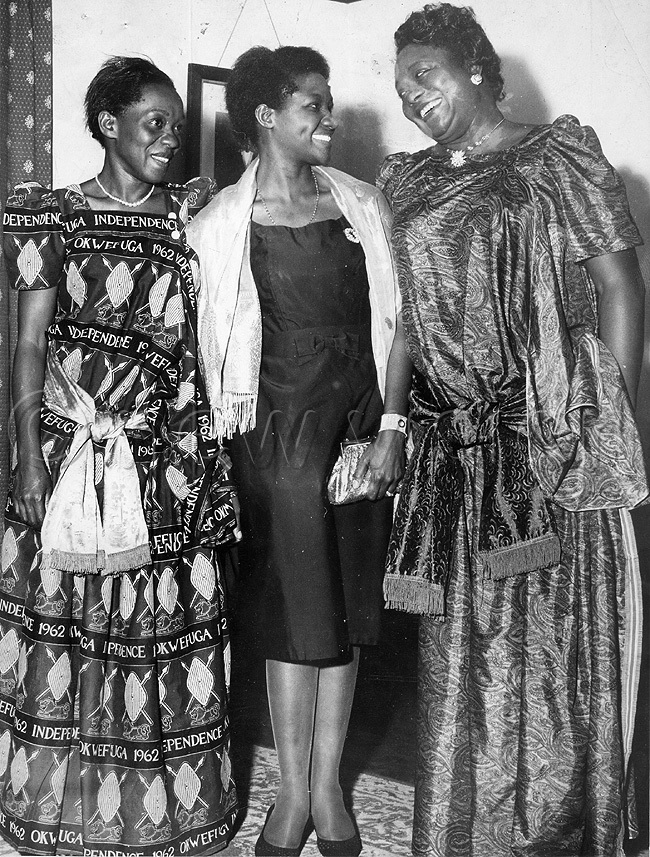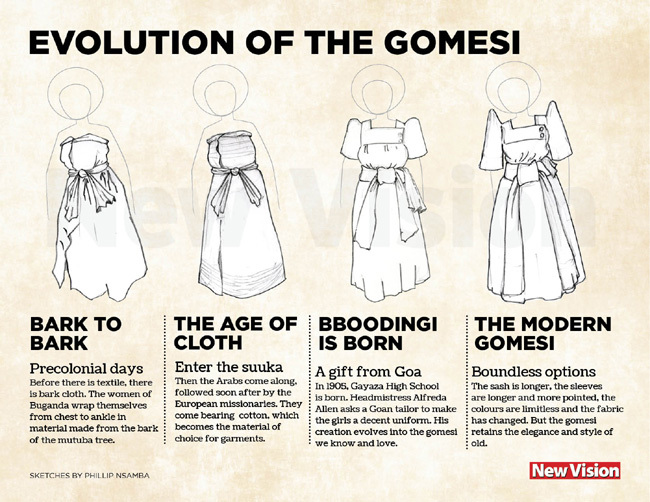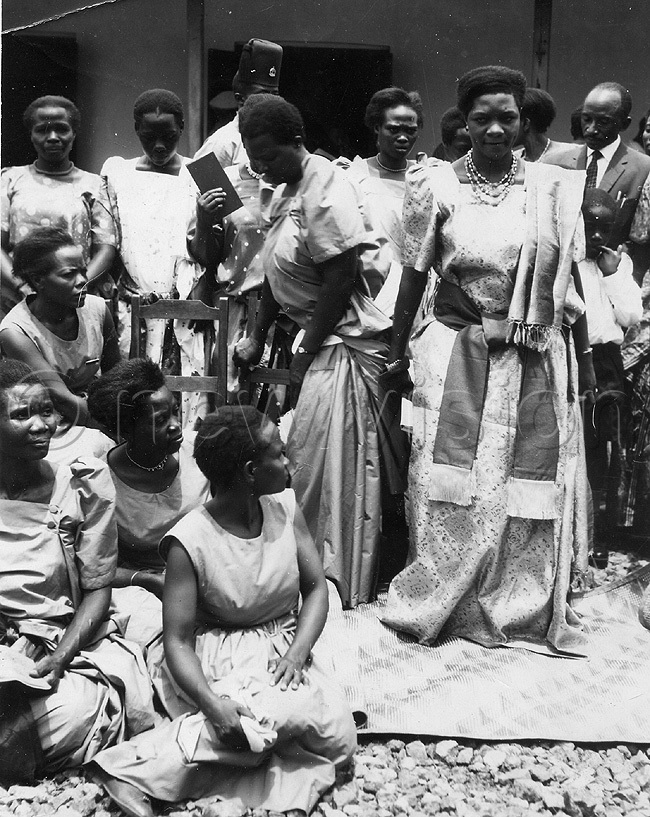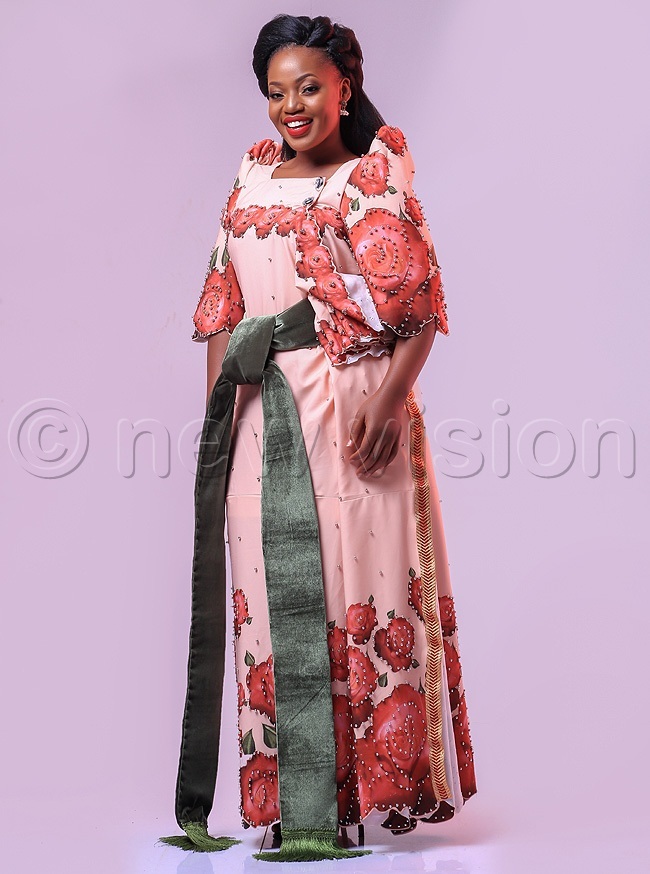The gomesi: Uganda's treasured dress
Although the Baganda of the central region still claim the gomesi as their own, from north to South, east to West Nile, women have made permanent room for it in their wardrobes.
CELEBRATING UGANDAN STYLE: PART 1
In a constantly changing and increasingly global world, many traditions are thrown by the wayside as culture evolves. What remains unchanging is the need to belong, often expressed in what we wear, when and how. In this article, we celebrate the gomesi, one of Uganda's most popular pieces of clothing.

Few items of apparel can today be said to be as quintessentially Ugandan as the gomesi. A luxurious display of colour and texture, the gomesi is a work of art, lending elegance and an air of regality to its wearer.
Once fully claimed as a Kiganda traditional dress, the gomesi has morphed into a Ugandan trademark. Although the Baganda of the central region still claim it as their own, from north to South, east to West Nile, women have made permanent room for it in their wardrobes.
It is not surprising to see any woman wearing a gomesi no matter which part of the country she is from. From excited parliamentarians being sworn into office (see picture immediately below), to participants in a cultural wedding ceremony in Gulu and national sports teams representing the country abroad, the gomesi transcends barriers.
It unites women of different shapes and shades.

A dress for all seasons
Elaborate and yet elegant, the gomesi is appropriate for every occasion - happy or sad. It is worn at weddings, graduation ceremonies, anniversaries, as well as funerals. Some women, particularly of the older generation, even wear it as they go about their daily chores.
There are certain subtleties attached to the wearing of the gomesi for different occasions. The gomesi worn at home, for instance, is made from light materials, such as chiffon, silk or satin, which are easy to wash. The sash is short to allow free movement.
 Back in the day, the gomesi sashes were very short
Back in the day, the gomesi sashes were very short
Pherry Ngabo, a resident of Buloba, and who is in her 70s, says when wearing the gomesi for a happy occasion, the piece of material that is typically folded over the sash is done neatly (okutereza in Luganda), leaving the sash exposed at the back.
"However, when you are going to a funeral or simply wearing the gomesi at home, you simply pull the fold over the sash at the back (kukubira), without much ceremony."
Ngabo says she first wore a gomesi as a young lady in December 1970. "It was for my kwanjula (introduction ceremony). My fiancé gave me the money to buy it," she recalls.
For her, starting to wear a gomesi was some sort of rite of passage, separating girl from woman. "At a certain age, when you do not wear the gomesi, you are not taken as seriously as someone who does," she says.
Frieda Musoke, who is in her 80s, is inclined to agree. "A gomesi sets a married woman apart, and earns her respect."
 Then-First Lady Miria Kalule Obote lighting a Christmas tree at State House Entebbe in 1984
Then-First Lady Miria Kalule Obote lighting a Christmas tree at State House Entebbe in 1984
Musoke acquired her first gomesi when she was 18 years old and engaged to be married. "Before that, I used to wear ordinary dresses, but my mother told me a married woman had to wear a gomesi. So she gave me one."
When Musoke arrived in her new home following her 1955 wedding, her mother-in-law gave her a second gomesi; it was a full package, from dress to sash and kikoyi and even shoes.
"I never wore ordinary dresses again, except for the maternity dress I wore when I was pregnant with my first child," she says.
Of the various changes she has seen the gomesi undergo over the years, Musoke says: "There is nothing wrong with change. It is all about fashion and people can choose what they want to wear."
While some of today's generation find the gomesi unwieldy and maybe even out of sync with the pace and nature of their lives, the gomesi endures, particularly for special events. Rarely does a cultural wedding occur without the colourful sight of young ladies clad in beautiful gomesis.
Hajara Namukwaya, better known as artiste Spice Diana, says the gomesi remains relevant in this her generation because it provides identity for Ugandans and Baganda in particular. "At cultural events like introductions, the gomesi is the official wear for women. However, just like with any other outfit, it is important to know when, where and how to wear it."
She says she owns two gomesis, and whenever she has a function to attend, she simply hires one.
Back to the beginning

While the staying power of the gomesi is not debatable, the origins of the dress are not always agreed on. It is generally accepted that the gomesi in the shape and form that it appears today has it beginnings in Gayaza High School. When this girls' school opened in 1905, it was the suuka that the daughters of mainly chiefs wore to school.
Pictures from the early days of Gayaza High School show students in this ankle-length piece of material that covered the body from just above the bust, leaving the shoulders bare. The material was fastened at the waist with another strip of cloth. The attire had evolved from a version of it made from bark cloth that had been replaced with the more lasting fabric introduced by the Arabs and missionaries in the mid to late 19th century.
A problem soon arose at Gayaza, however, says Felista Mukasa, a retired teacher. The suukas would always loosen around the bust whenever the girls engaged in strenuous activity, such as chores, exposing their bosoms, to the consternation of the missionaries.
"The story is told that Miss Alfreda Allen, the first headmistress of Gayaza Junior School, asked a Goan tailor to make the school's first school uniform," she says.
To the suuka, Caetano Milagres Gomes added a yoke and sleeves. This gave birth to what we know today as the gomesi (named after its creator). Because Gayaza High School was a boarding school, the school uniform soon earned the tag ‘bboodingi' and the attire made its way into popular culture.
 Former Nnabagereka of Buganda, Lady Damalie Kisosonkole (right), wore a gomesi with a slightly longer sash
Former Nnabagereka of Buganda, Lady Damalie Kisosonkole (right), wore a gomesi with a slightly longer sash
Transitions
Over the years, the gomesi has seen modifications made to it. Ngabo says the basic style of the gomesi has remained constant. "Perhaps what has changed significantly is the sash. We wore short sashes back then. Today, the sashes are long," she says.
The sleeves have also been modified, from short and squarish to long and pointed.
Gone, too, are the days when the gomesi came in basic colours and fabric. Today, there is a kaleidoscope of colour and many options of fabric and accessories for someone looking to stand out in their gomesi.
Designers of contemporary attire are also getting inspiration from the traditional dress.
ALSO RELATED: Miss World shines in Tina Brad Gomesi
 Mourning Baganda women outside Kasubi tombs in the 1940s
Mourning Baganda women outside Kasubi tombs in the 1940s
Accessorise it
A gomesi is incomplete without accessories, and particularly an appropriate sash. Salim Ssali, a designer with Kushona Designers at Zai Plaza, is of the view that women should pay attention to the sash as much as the gomesi.
"The colour of the sash should be the one which least appears in the entire gomesi," he advises.
For a perfect picture look, match the shoes with the sash.
 The gomesi today
The gomesi today
 Ugandan female legislators clad in gomesi at the official opening of the 64th CPC in Kampala
Ugandan female legislators clad in gomesi at the official opening of the 64th CPC in Kampala
When it comes to jewellery, the embellishments on the material should guide the wearer on the best accessories to settle for.
"Some gomesis are so decorated that one does not need a necklace, but only dangling earrings," Ssali says.
Some, however, like Tina Najjuka, a dealer in fabric, feel that when it comes to the bridal gomesi, a necklace is always necessary. However embellished a gomesi is, a bride needs to stand out.
Ultimately, however, it is all a matter of choice. And with the myriad of options available, the gomesi can only continue to sparkle.
In the next article in our series, we share current gomesi trends.
ALSO RELATED TO THIS STORY
How to wear the gomesi
Celebrating Ugandan style: An ageless adventure